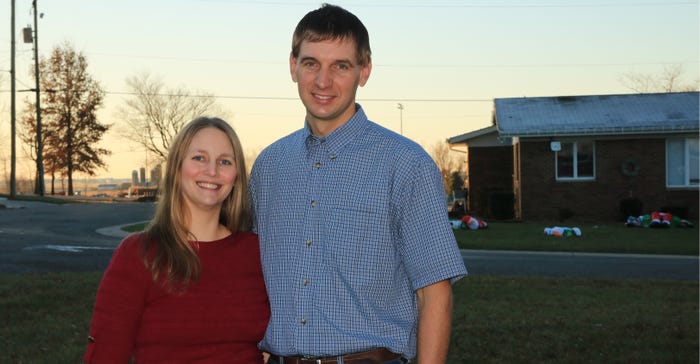
Scott and Amber Poettker of Clinton County, Ill., were well into their 16th year farming when the coronavirus shutdown began to sink ag commodity prices. But rather than sell their quarterly load of fat Holstein steers at a 30% discount from where prices started in January, they benefited from locking in higher prices before markets fell through a contract with United Producers in Salem, Ill.
“I’m well pleased with how the sale went. I probably did 20 cents better than if I just sold it as is,” Scott says. Good timing paid off; April was the first contracted load of his farming career, having spent the last 15 years building up a herd large enough to meet their quarterly demand of 35 steers. He and Amber also farm about 190 acres among three separate farms, one of which is rented.
With prices for Holstein cattle running with a 16-cent basis below the live cattle futures market when he sold, Scott says, “It could have definitely been worse.” Scott’s brother Eric Poettker joined him in loading 11 steers in addition to Scott’s 26.
“I’ve got three more loads coming this year, and I’m kind of worried about them, because I didn’t lock the price in before prices fell,” Scott says. “Right now, I’m just trying to hold steady and waiting it out, more or less.”
Holding steady is a challenge, but by working together with his brother and father, Duane, he says the group is optimistic they’ll lock in another contract for February 2021.
“They can all get in on this benefit during these hard times,” Scott says.
Building a homestead
Scott says he was able to enter farming after graduating from high school by taking over some of the barns a retiring uncle had left behind. He then began buying Holstein steers, a mainstay of dairy-focused Clinton County. As his father moved away from feeding and selling Holstein steers in favor of robot milking barns, Scott took over the old barns and continued to build up his herd gradually to his current capacity of about 130.
In December, Amber and Scott bought a piece of land in Trenton, Ill., that last year was used to grow corn. They plan to build a house there, as it’s centrally located to both Scott’s and Amber’s parents.
Scott says every year, two of his three farms must go to corn to feed his cattle. He also double-crops soybeans and wheat, bringing the harvests and the year’s leftover corn into town to sell.
“We keep the steers on all corn, all the time,” Scott says, noting that for his newly bought young Holsteins, he feeds molasses with the corn to get them to like the grain-based feed throughout their lives. They also keep a bale of free choice straw stocked in the barns.
“They can either go to the straw bunk or the grain bunk. And I would say the straw makes up about 5% to 10% of their diets,” Scott says, pointing to the 400-pound newly purchased Holsteins. “They’ll probably eat 10 to 12 pounds of grain per head per day. Once they get fat, then they’re pushing 20 to 24 pounds per head per day. They put a lot of grain away in a hurry.”
Scott says his ultimate goal is to be a full-time farmer. “I don’t know if that’s ever going to happen, but it’s a goal to try and reach,” he says.
Growing past challenges
Amber works as a physician’s assistant at a rural health clinic in Breese, Ill., while Scott’s day job is at Top Ag Cooperative. They have four children.
“We both work full time, and then he farms on the side,” Amber says. “We are busy all the time, so spring and fall are stressful and busy months for us. We don’t ever really get caught up.” She notes that during harvesttime, she sometimes feels like a single mom. “What doesn’t have to get done just waits until we can get to it,” she says.
Scott and Amber are members of the Cultivating Master Farmers program, a two-year schedule of gatherings between young farmers and Master Farmer award recipients sponsored by Farm Credit Illinois, Compeer Financial, Illinois Farm Bureau, Growmark, Bayer and Prairie Farmer.
“We hope to learn more about agriculture and to better our business through the program,” Amber says.
“We’re doing this to learn — to get out there and try to figure out what we can do better,” Scott concludes.
Read more about:
Cultivating Master FarmersAbout the Author(s)
You May Also Like




